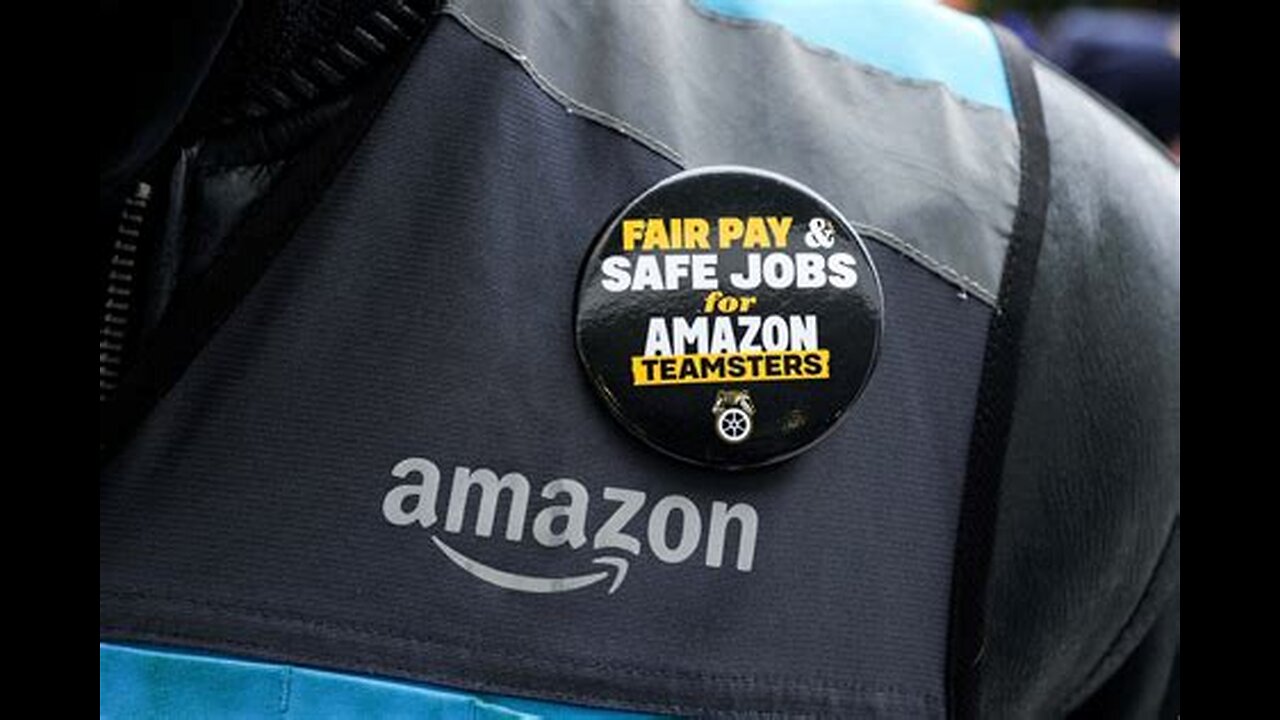Premium Only Content

Coventry at the Crossroads: Amazon’s Labor Struggles and the Future of Worker Rights
Amazon, the global e-commerce powerhouse, has revolutionized the way the world shops. Yet, beneath its high-tech veneer lies a brewing labor crisis. In Coventry, UK, Amazon’s warehouse workers have repeatedly gone on strike, making headlines and sparking debates about the future of worker rights in the digital economy. These strikes, the first of their kind against Amazon in the UK, offer a window into the challenges of balancing operational efficiency with employee dignity.
This article explores the roots of Coventry’s labor unrest, its global context, and its potential to shape the future of work.
I. The Genesis of Labor Unrest: Seeds of Discontent
In January 2023, Coventry became the epicenter of a historic labor movement when Amazon workers staged the first-ever strike against the company in the UK. The catalyst? A combination of rising living costs, stagnant wages, and increasingly demanding workplace conditions.
• Rising Costs and Insufficient Pay: Workers protested a pay increase of just 5%, which raised hourly wages to £10.50. Amid soaring inflation and a cost-of-living crisis, many workers argued this adjustment was woefully inadequate.
• A Surveillance-Driven Workplace: Employees reported working under intense monitoring, with even short breaks triggering scrutiny for “idle time.” The rigid performance metrics created a dehumanizing atmosphere, exacerbating worker dissatisfaction.
II. The Escalation of Labor Action
As the movement gained momentum, workers strategically timed strikes to disrupt Amazon’s busiest periods, including Black Friday and holiday shopping seasons. Their demands went beyond pay increases to include improved working conditions and fair treatment.
• A Living Wage Demand: Workers, supported by the GMB Union, called for a minimum pay rate of £15 an hour. This demand aligns with broader global movements advocating for fair compensation in labor-intensive industries.
• Coordinated Action: Strikes at Coventry highlighted workers’ ability to disrupt operations in a company reliant on seamless logistics, forcing Amazon to confront the growing power of organized labor.
III. Allegations of Anti-Union Practices: A Battle for Recognition
The strikes also revealed a contentious battle over union recognition and worker representation.
• Union Dilution Tactics: Amazon faced accusations of hiring additional staff to dilute union membership percentages, undermining efforts to achieve formal recognition.
• Pressure on Union Members: Workers reported feeling intimidated and pressured to distance themselves from union activities, raising concerns about Amazon’s commitment to fair labor practices.
IV. Voices from the Ground: Worker Testimonies
Amid the corporate narratives and union statements, the voices of Coventry workers add a human dimension to the story.
• Grievances and Demands: “We’re not just asking for more money—we’re asking for respect,” said one warehouse worker. “The work is exhausting, and the constant surveillance makes it unbearable.”
• Physical Toll: Another employee highlighted the physical demands of the job: “The pace is relentless, and you feel like you’re just a cog in a machine.”
V. Amazon’s Response: A Corporate Perspective
Amazon has consistently defended its labor practices, emphasizing competitive wages and benefits.
• Industry Standards: “Our pay is among the highest in the logistics industry,” a spokesperson stated. The company also pointed to employee perks like private health insurance and career advancement programs.
• Direct Engagement: Amazon has expressed a preference for direct engagement with employees over union negotiations, a stance that critics argue undermines collective bargaining efforts.
VI. Contextualizing Coventry: A Global Labor Movement
The Coventry strikes are part of a broader, global conversation about labor rights in the modern economy.
• The Gig Economy’s Dilemmas: Like Coventry workers, employees in gig and fulfillment roles worldwide face similar struggles with low wages, high demands, and minimal job security.
• Global Echoes: Amazon warehouses in the United States and Europe have seen similar labor actions, highlighting recurring themes of worker discontent across the company’s global operations.
VII. Broader Implications: The Future of Labor Relations
The Coventry strikes underscore critical issues that extend far beyond Amazon.
• Automation and Job Security: As automation increasingly replaces manual labor, workers face the dual challenge of job insecurity and heightened performance expectations.
• Union Resurgence: Coventry reflects a broader resurgence of union activity, particularly in sectors historically resistant to organized labor, such as tech and logistics.
• Corporate Accountability: How companies like Amazon respond to labor disputes could influence public trust and regulatory scrutiny, shaping the broader landscape of corporate responsibility.
VIII. Forward-Thinking Solutions: Bridging the Divide
As Amazon navigates these challenges, there are opportunities to create a more equitable relationship between employers and employees.
• Collaborative Bargaining Models: Innovative frameworks, such as profit-sharing agreements or worker councils, could bridge gaps between corporate goals and employee needs.
• Regulatory Interventions: Governments have a role to play in enforcing fair wage standards and protecting union rights, ensuring accountability in industries with significant power imbalances.
• Consumer Awareness: Consumers wield influence through purchasing decisions. Public pressure on corporations to adopt ethical labor practices can drive meaningful change.
IX. A Call to Action: Rethinking the Worker-Employer Relationship
The Coventry strikes highlight a fundamental truth: operational efficiency cannot come at the expense of human dignity. Companies must move beyond viewing workers as mere resources and recognize their role as integral contributors to success.
• Empathy in Leadership: Treating employees with respect and valuing their contributions fosters loyalty, morale, and productivity.
• Sustainable Workforce Practices: Balancing efficiency with fair treatment is not just ethical—it’s essential for long-term viability in an evolving labor market.
Conclusion: Coventry as a Catalyst for Change
The labor unrest at Amazon’s Coventry warehouse is not just a localized dispute—it is a microcosm of the broader challenges facing workers in the modern economy. As workers demand fair pay, humane conditions, and a voice in decision-making, Coventry has become a symbol of resistance and a call for reform.
The outcome of these strikes could set a precedent for labor relations in the tech-driven logistics industry, redefining what it means to balance innovation with humanity. As Amazon and other corporations grapple with these issues, Coventry’s legacy may inspire a new era of worker empowerment, shaping the future of labor rights in an increasingly automated world.
-
 1:04
1:04
FragmentsOfTruth
3 days agoThe Hidden Truth About Sugar: How It Shuts Down Your Immune System
189 -
 52:02
52:02
Candace Show Podcast
6 hours agoBecoming Brigitte: An Inaccessible Past | Ep 2
84.5K114 -
 LIVE
LIVE
2 MIKES LIVE
4 hours ago2 MIKES LIVE #176 News Breakdown Wednesday!
158 watching -
 LIVE
LIVE
I_Came_With_Fire_Podcast
5 hours agoGAZA TAKEOVER | USAID EXPLAINED | TARIFF TAKEDOWN
455 watching -
 LIVE
LIVE
The Based Mother
5 hours agoFULL OF IT! Crooked politicians say they care about children. Their actions tell a different story.
116 watching -
 1:54:12
1:54:12
Right Side Broadcasting Network
8 hours agoLIVE: President Trump Signs EOs; Pete Hegseth Meets with Netanyahu - 2/5/25
99.7K45 -
 1:51:41
1:51:41
Dr. Drew
6 hours agoPsychics Investigate DC Black Hawk & Philadelphia Medical Plane Crashes w/ Zach Vorhies + Eddie Conner & Andrew Anderson – Calling Out w/ Susan Pinsky – Ep 166
55.9K19 -
 1:03:04
1:03:04
In The Litter Box w/ Jewels & Catturd
23 hours agoDemocrats Come Unglued | In the Litter Box w/ Jewels and Catturd Ep. 735 - 2/5/2025
68.4K63 -
 1:44:25
1:44:25
The Quartering
6 hours agoTrump Impeachment, Democrat Insurrection, Massive Scandal At Politico & DC Crash Update!
108K52 -
 LIVE
LIVE
Dr Disrespect
8 hours ago🔴LIVE - DR DISRESPECT - KINGDOM COME: DELIVERANCE 2 - FIRST IMPRESSION
2,475 watching